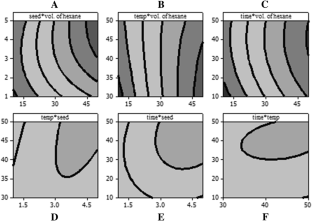Temperature mediated extraction of oil from safflower seeds: modelling and optimization of extraction parameters by response surface methodology approach
Singhal Gauri, Singh Priyanka, Bhagyawant Sameer Suresh, Srivastava Nidhi
Research Articles | Published: 01 November, 2019
First Page: 540
Last Page: 546
Views: 3762
Keywords: Safflower seed oil, Thermal pretreatment, Response surface methodology, Oil percentage
Abstract
Safflower seed oil reveals well known therapeutic values. Response surface methodology (RSM), an effective statistical tool was used to study the enhancement of its oil percentage. A central composite design was applied to evaluate effects of four independent parameters like seed amount, reaction time, volume of hexane and temperature on oil extraction from its seeds. Oil percentage has been estimated as 22.76%, 21.73% and 25.1% respectively after thermal pretreatment for 10, 20 and 30 min. The optimized parameters were obtained as 3 g for the amount of seeds, 30 min for extraction process, 30 ml for volume of hexane and 45 °C temperature after applying RSM. The predicted oil percentage was obtained as 31.968% by second order polynomial equation while the estimated oil percentage was 50.12% for the optimum parameters. The oil percentage has been enhanced almost two times by using RSM. Statistically, the optimization of extraction parameters for the maximum oil recovery may add a positive value in the safflower crop with world economy.

References
- Adel AAM, Awad AM, Mohamed HH, Iryna S (2015) Chemical composition, physicochemical properties and fatty acid profile of Tiger Nut (Cyperus esculentus L.) seed oil as affected by different preparation methods. Int J Food Res 22:1931–1938
- Akinoso R, Aboaba SA, Olajide WO (2011) Optimization of roasting temperature and time during oil extraction from orange (Citrus sinensis) seeds: a response surface methodology approach. Afr J Food Agric Nutr Dev 11:5300–5317
- Azmir J, Zaidul ISM, Rahman MM, Sharif KM, Sahena F, Jahurul MHA (2014) Optimization of oil percentage of Phaleria macrocarpa seed using response surface. Ind Crops Prod 52:405–412
- Betschart AA, Lyon CK, Kohler GO (1975) Sunflower, safflower, sesame and castor proteins. In: Pirie NW (ed) Food protein sources. Cambridge University Press, London, pp 79–104
- Bocevska M, Kadovi D, Turkulov J, Pericin D (1993) Quality of corn germ oil obtained by aqueous enzymatic extraction. J Am Oil Chem Soc 70:1273–1277
- Camas NC, Irak C, Esendal E (2007) Seed yield, oil percentage and fatty acids composition of safflower (Carthamus tinctorius L.) grown in Northern Turkey conditions. Ann Agric Sci 22:98–104
- Chabrand MR, Kim HJ, Zhang C, Glatz EC, Jung S (2008) Destabilization of the emulsion formed during aqueous extraction of soybean oil. J Am Oil Chem Soc 85:383–390
- Huijing L, Chunlei S, Huiming Z, Na W, Dawei C (2011) Optimization of the aqueous enzymatic extraction of wheat germ oil using response surface methodology. J Am Oil Chem Soc 88:809–817
- Karlovic DJ, Bocevska M, Jakolevic J, Turkulov J (1994) Corn germ oil extraction by a new enzymatic process. Acta Aliment 23:389–400
- Lee YY, Tang TK, Phuah ET, Karim NAA, Alwi SMM, Lai OM (2015) Palm-based medium-and-long-chain triacylglycerol (PMLCT): production via enzymatic interesterification and optimization using response surface methodology (RSM). J Food Sci Technol 52:685–696
- Mabayo VIF, Aranas JRC, Cagas VJB, Cagas DPA, Ido AL, Arazo RO (2018) Optimization of oil yield from Hevea brasiliensis seeds through ultrasonic-assisted solvent extraction via response surface methodology. Sustain Environ Res 28:39–46
- Man YBC, Karim MIBA, Teng CT (1997) Extraction of coconut oil with Lactobacillus plantarum 1041 IAM. J Am Oil Chem Soc 74:1115–1119
- Mishra G, Joshi DC, Mohapatra D (2015) Optimization of pretreatments and process parameters for sorghum popping in microwave oven using response surface methodology. J Food Sci Technol 52:7839–7849
- Mizutani Y, Shibata M, Yamada S, Nanbu Y, Hirotsuka M, Matsumura Y (2018) Effects of heat treatment under low moisture conditions on the protein and oil in soybean seeds. Food Chem. https://doi.org/10.1016/j.foodchem.2018.09.139
- Olajide JO, Afolabi TJ, Adeniran JA (2014) Optimization of oil percentage from groundnut kernel (Arachis hypogeae) in a hydraulic press using response surface methodology. J Sci Res Rep 3:1916–1926
- Porto CD, Voinovich D, Natolino A (2012) Response surface optimization of hemp seed (Cannabis sativa L.) oil percentage and oxidation stability by supercritical carbon dioxide extraction. J Super Fluids 68:45–51
- Sharma A, Khare SK, Gupta MN (2002) Enzyme assisted aqueous extraction of peanut oil. J Am Oil Chem Soc 79:215–218
- Shende D, Sidhu GK (2016) Response surface methodology to optimize enzyme-assisted aqueous extraction of maize germ oil. J Food Sci Technol 53:3282–3295
- Smith JR (1996) Safflower. AOCS Press, Champaign
- Soto C, Chamy R, Zuniga ME (2007) Enzymatic hydrolysis and pressing conditions effect on borage oil extraction by cold pressing. J Food Chem 102:834–840
- Wakelyn PJ, Wan PJ (2006) Solvent extraction to obtain edible oil products. In: Akoh CC (ed) Handbook of functional lipids. CRC Press, Boca Raton, pp 89–131
- Zhong K, Lin W, Wang Q, Zhou S (2012) Extraction and radical scavenging activity of polysaccharides with microwave extraction from mung bean hulls. Int J Biol Macromol 51:612–615
- Zhu Z, Rosendahl L, Toor SS, Chen G (2018) Optimizing the conditions for hydrothermal liquefaction of barley straw for bio-crude oil production using response surface methodology. Sci Total Environ 630:560–569
Author Information
Department of Bioscience and Biotechnology, Banasthali Vidyapith, Vanasthali, India